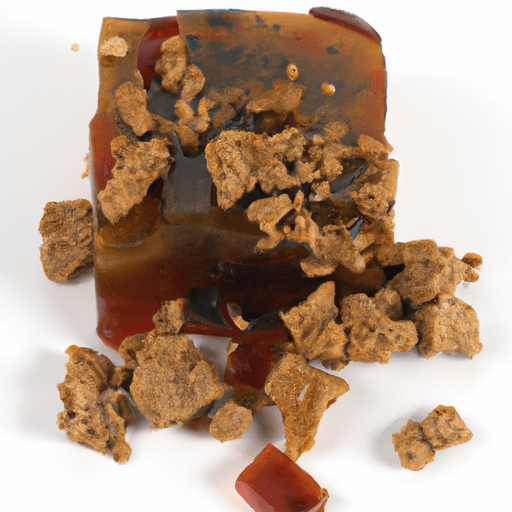The Delectable Delights of Butter Toffee: A Rich, Crunchy Treat
If you’re a fan of sweet treats that melt in your mouth and leave you craving for more, then butter toffee might be just the indulgence you’re looking for. This delightful confection embodies the perfect balance of a rich buttery flavor, a heavenly sweetness, and a satisfying crunch. Whether enjoyed as a standalone treat or used as an ingredient in other culinary creations, butter toffee never fails to impress.
The Taste: A Symphony of Butter, Sugar, and Crunch
Butter toffee is a tantalizing blend of three simple yet irresistible ingredients: butter, sugar, and nuts. When prepared to perfection, these components harmonize to create a symphony of flavors and textures. The butter provides a smooth and creamy richness, complemented by the deep caramel notes of the sugar. As you take a bite, the toffee crackles and crunches beneath your teeth, releasing a burst of nuttiness that adds an extra layer of delight to every mouthful.
Common Uses in Cooking: The Versatile Delicacy
Butter toffee is not only a delightful treat on its own but also a versatile ingredient in various culinary endeavors. Its exquisite flavor profile lends itself to a wide range of uses:
- Topping: Crushed butter toffee can be sprinkled over ice cream, cupcakes, or cookies to bring a delightful crunch and a touch of sweetness.
- Baking: Butter toffee bits can be added to cookie dough, brownie batter, or cake mix to infuse baked goods with a mouthwatering toffee flavor and a delightful texture.
- Candy Making: Butter toffee can be molded into various shapes, such as bars or bite-sized pieces, to create homemade candies that are perfect for gifting or adorning dessert platters.
- Snacking: Of course, butter toffee is a snack in its own right! Its addictive combination of flavors and textures makes it a popular choice for movie nights, parties, or simply indulging yourself with a tasty treat.
Nutritional Value: A Treat to Enjoy in Moderation
While butter toffee is undoubtedly a decadent delight, it’s important to enjoy it in moderation due to its high sugar and fat content. However, amidst the indulgence, butter toffee does provide a few nutritional benefits. Nuts, a common ingredient in butter toffee, offer a good source of protein, healthy fats, fiber, vitamins, and minerals. Additionally, small amounts of butter can contribute to your daily intake of essential nutrients like vitamins A and E.
History and Fun Facts: Sweet Stories Behind the Toffee
The origins of butter toffee can be traced back to the early 19th century in England, where it is said to have been enjoyed as a confectionery treat. Over time, it gained popularity around the world and evolved into different variations, each with its own unique twist.
Interestingly, the process of making butter toffee involves heating sugar and butter together until they reach the hard crack stage, at around 300°F (150°C). This ensures that the toffee achieves its signature crunchy texture. Adding nuts, such as almonds or walnuts, to the mixture brings an extra dimension of flavor and texture to the final product.
In conclusion, butter toffee is a mouthwatering delight that combines the creaminess of butter, the sweetness of sugar, and the crunch of nuts. Its versatility in cooking opens up a world of possibilities for anyone with a sweet tooth. So, the next time you’re looking for a treat that offers a symphony of flavors and an irresistible crunch, reach for a piece of butter toffee and indulge in its remarkable deliciousness.
Butter Toffee
Origin: Butter toffee originated in England around the late 19th century. It is believed to be a variation of traditional toffee, but with the addition of butter for a rich and creamy flavor.
Common uses: Butter toffee is often enjoyed as a sweet treat on its own, but it is also commonly used as a topping or ingredient in desserts such as cookies, cakes, and ice cream. It can also be used as a filling in chocolates or enjoyed as part of a candy assortment.
Nutritional benefits: Butter toffee is high in sugar and calories, so it is best enjoyed in moderation. It is a good source of carbohydrates, providing a quick source of energy. However, it is low in essential nutrients such as vitamins and minerals.
Unique properties: Butter toffee is known for its sweet, buttery flavor and crunchy texture. The combination of sugar, butter, and sometimes nuts creates a rich and indulgent treat. It has a distinct caramel-like taste, enhanced by the caramelization of the sugar during the cooking process.
Historical significance: Toffee itself has a long history, dating back to at least the 18th century. The addition of butter to traditional toffee likely occurred in the late 19th century, creating what we now know as butter toffee. Over the years, butter toffee has become a popular confectionery item enjoyed around the world.




Use the share button below if you liked it.
It makes me smile, when I see it.